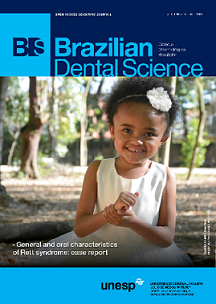Retentive force comparison between esthetic and metal clasps for removable partial denture
DOI:
https://doi.org/10.14295/bds.2017.v20i3.1431Resumo
Objective: This study aimed to evaluate the retention of acetate resin clasp as when compared to metal clasp. Material and methods: For this purpose, we constructed 10 conventional Co-Cr metal clasps (Ackers) and 20 acetate resin clasps. The acetate resin clasps had the opposition, support and retaining arms made of Co-Cr. Of the 20 esthetic clasps, 10 had the thickness of the retention arm decreased to make it more esthetic. The initial retentive force of the specimens was tested in a universal testing machine through tensile test. After that, the specimens were subjected to 7,000 cycles, each one, in an adapted machine, immersed into artificial saliva, for 36 months of simulated clinical use of a removable partial denture. Data were tabulated for statistical analysis of the retention effectiveness. Results: After cycling, 3-mm-thick and 2-mm-thick acetate resin clasps lost more retention than metal clasps. The material type (p=0.0000) and cycling (p=0.0039) showed a significant effect, but the material/cycling interaction (p=0.1436) did not. Conclusions: Therefore, esthetic clasps presented retention force lower than that of metal clasps. Notwithstanding, the esthetic clasps can be used in clinical cases requiring minimum retention.
Keywords
Removable partial denture; Esthetic clasp; Metal clasp.
Downloads
Downloads
Arquivos adicionais
Publicado
Como Citar
Edição
Seção
Licença
TRANSFERÊNCIA DE DIREITOS AUTORAIS E DECLARAÇÃO DE RESPONSABILIDADE
Toda a propriedade de direitos autorais do artigo "____________________________________________________________________" é transferido do autor(es) para a CIÊNCIA ODONTOLÓGICA BRASILEIRA, no caso do trabalho ser publicado. O artigo não foi publicado em outro lugar e não foi submetido simultaneamente para publicação em outra revista.
Vimos por meio deste, atestar que trabalho é original e não apresenta dados manipulados, fraude ou plágio. Fizemos contribuição científica significativa para o estudo e estamos cientes dos dados apresentados e de acordo com a versão final do artigo. Assumimos total responsabilidade pelos aspectos éticos do estudo.
Este texto deve ser impresso e assinado por todos os autores. A versão digitalizada deverá ser apresentada como arquivo suplementar durante o processo de submissão.




























